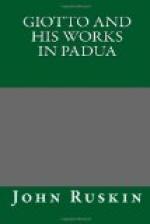This chapel, built in or about the year 1303,[2] appears to have been intended to replace one which had long existed on the spot; and in which, from the year 1278, an annual festival had been held on Lady-day, in which the Annunciation was represented in the manner of our English mysteries (and under the same title: “una sacra rappresentazione di quel mistero"), with dialogue, and music both vocal and instrumental. Scrovegno’s purchase of the ground could not be allowed to interfere with the national custom; but he is reported by some writers to have rebuilt the chapel with greater costliness, in order, as far as possible, to efface the memory of his father’s unhappy life. But Federici, in his history of the Cavalieri Godenti, supposes that Scrovegno was a member of that body, and was assisted by them in decorating the new edifice. The order of Cavalieri Godenti was instituted in the beginning of the thirteenth century, to defend the “existence,” as Selvatico states it, but more accurately the dignity, of the Virgin, against the various heretics by whom it was beginning to be assailed. Her knights were first called Cavaliers of St. Mary; but soon increased in power and riches to such a degree, that, from their general habits of life, they received the nickname of the “Merry Brothers.” Federici gives forcible reasons for his opinion that the Arena Chapel was employed in the ceremonies of their order; and Lord Lindsay observes, that the fulness with which the history of the Virgin is recounted on its walls, adds to the plausibility of his supposition.
[Footnote 2: For these historical details I am chiefly indebted to the very careful treatise of Selvatico, Sulla Cappellina degli Scrovegni nell’Arena di Padova. Padua, 1836.]
Enrico Scrovegno was, however, towards the close of his life, driven into exile, and died at Venice in 1320. But he was buried in the chapel he had built; and has one small monument in the sacristy, as the founder of the building, in which he is represented under a Gothic niche, standing, with his hands clasped and his eyes raised; while behind the altar is his tomb, on which, as usual at the period, is a recumbent statue of him. The chapel itself may not unwarrantably be considered as one of the first efforts of Popery in resistance of the Reformation: for the Reformation, though not victorious till the sixteenth, began in reality in the thirteenth century; and the remonstrances of such bishops as our own Grossteste, the martyrdoms of the Albigenses in the Dominican crusades, and the murmurs of those “heretics” against whose aspersions of the majesty of the Virgin this chivalrous order of the Cavalieri Godenti was instituted, were as truly the signs of the approach of a new era in religion, as the opponent work of Giotto on the walls of the Arena was a sign of the approach of a new era in art.




